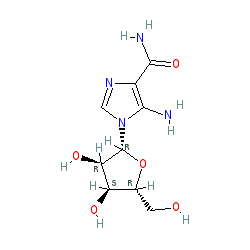|
Synonyms: AICA-riboside | AR-100 | SCH-900395
Compound class:
Synthetic organic
|
|
|||||||||||||||||||||||||||||||||||
| No information available. |
Summary of Clinical Use  |
| It is postulated that activation of AMPK may have clinical potential for correcting defects in the insulin signaling cascade in patients with type 2 diabetes [5,7]. There are no active clinical trials registered on ClinicalTrials.gov (May 2014) |
Mechanism Of Action and Pharmacodynamic Effects  |
| 5' AMP-activated protein kinase (AMPK) is a trimeric protein complex containing an α, a β, and a γ subunit. In humans there are genes for 2 α, 2 β and 3 γ protein isoforms. AMPK activation regulates many metabolic pathways, including hepatic ketogenesis, cholesterol synthesis, lipogenesis [3], triglyceride synthesis, adipocyte lipolysis, skeletal muscle fatty acid oxidation [4], and is potentially involved in insulin secretion and contraction-induced glucose uptake in muscle cells [2,6]. |







